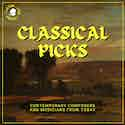

In the era of music streaming, classical music is often overlooked by the music industry. At iMusician, we believe that the genre of the music you make and produce should showcase your strengths not cause you trouble. Classical music promotion should not be an exception to that. In this article, we will show you how to promote your music as an independent classical music artist.
1. Create a professional artist page
A professional, well-designed artist page is a must for any classical music artist. It should be not only the first place your fans go to to learn more about you and your music but also the contact point for potential collaborators, promoters, or journalists.
You can either create a proper website or opt for a simply-made landing page that can further send your visitors to your streaming and download stores, social media platforms, concert dates, a merch store, etc. Such a landing page can be created using a smartlink tool, like our very own iMusician Release Pages. As a smartlink, Release Pages can help send your fans directly to your offers while integrating those destinations into one, single link. You can showcase your releases and link the stores where your audience can purchase and listen to it; feature the dates of your upcoming concerts with tickets to buy; or impress journalists and marketers with your electronic press kit with downloadable high-res files. Additionally, the page is easy to make as it requires no preliminary knowledge of web design or HTML.
With our Release Pages, you can also choose between a Release Page Free, Release Page Pro, and Release Page Pro+, depending on your current needs. As a result, you can take your music brand to another level with fully-customizable options or a pre-save page that turns into a release page automatically on release day. If you’d like to learn more about our Release Pages and all its features, check out the Release Pages product page on the portal.
Whatever format you choose, it’s crucial that your artist page includes all its relevant information (from your bio, to your music, to your contact form); it is up-to-date and has an appealing design. The design part is particularly relevant as it has the power to represent your artist brand (and your music, too) and help you retain the attention of your visitors. Impressive and attention-capturing visuals can also help you break through the noise of other classical music artists and set yourself apart.
2. Utilize music streaming platforms
After Primephonic was acquired by Apple in 2021, IDAGIO has remained the only purely classical music streaming platform. This is now to change as it was announced that Apple Music will launch its own classical music app, Apple Music Classical, using both the data and catalog of Primephonic. Already now, the app promises music from the world’s largest classical music catalog, a specialized search built specifically for the genre, and the highest audio quality available. This marks Apple Music as the first major streaming service to provide a special focus on classical music.
Although the other streaming services don’t, it is still relevant that you have your music available on them. Bear in mind that as of 2022, the number of streaming subscribers worldwide amounted to 616.2 million. What’s more, over 50% of all music in the world is consumed via streaming (either music or video streaming). This means that if you haven’t got your music on streaming platforms, like Spotify, Apple Music, Qobuz, Tidal, or Deezer, there might be a powerful audience waiting for you. From the platforms suggested, Qobuz and Tidal may be a great choice mostly for the high audio quality. Meanwhile, Spotify and Apple Music can provide you with the possibility to not only stream but also promote your music.
Something that the streaming platforms may be particularly great for is their playlists which present a useful tool for fans to discover new music. You can either create your own playlists or submit your songs for playlist consideration. This way you can get playlisted in the platforms’ editorial playlists (meaning they are credited by the editorial teams of the services) or get featured in the playlists of other curators. At iMusicia, we, too, curate our own playlists to help independent musicians get discovered. For classical music specifically, we have created ‘Classical Picks’ and ‘Relaxing Piano’ playlists on Spotify and Deezer. Send us your song and get playlisted today!


Get discovered through our playlists
By streaming your music, you can further collect valuable data, particularly such concerning your audience and their listening patterns. You can find out where exactly your music is consumed the most, what age groups listen to it most often and how do they get to discover your music. As a result, you can better understand your audience and know where to target your promotional and marketing efforts.
3. Use social media as well as traditional marketing methods
Now, social media rules the world and so they should definitely be utilized as a part of your marketing campaigns. However, we would recommend that you wisely select the exact platforms that you will use to promote yourself and your music. This is to make sure that you’re targeting the right audience and are not wasting time (and so money) on networks where your potential customers are simply not active.
Firstly, statistics continue to show that classical music is generally consumed by a middle-aged or older audience rather than young individuals. As of 2018, the majority of classical music fans worldwide were aged 55 or above. Such an audience may more likely to respond to more traditional promotional techniques like print advertising, emails, or even direct mail, rather than social media channels, namely Instagram, Snapchat, or TikTok.
On the other hand, statistics also depict that the genre’s global audience aged under 35 years old has been on the rise for a few years now, reaching more than 30% of the whole listening group. This age group might be more prone to connect with you and your music through social media, and may even prefer such channels to traditional ones.
How can I do it all, you may ask? The answer simply is: you can’t. Only by collecting data concerning your own music can you learn more about who your direct audience is, where they are located, and how they interact with the content you make. If you’re just starting out and have no profound knowledge of your audience yet, we would recommend combining traditional marketing techniques with only a few social media networks, most importantly Facebook (and Instagram should you have the capacity for that). Out of all social media channels, Facebook is the most popular among users aged 50 or above.
Would you like to learn more about how to promote your music on Facebook? Check out our guide on how to get the most out of Facebook for musicians on the portal!
Regarding the traditional methods, you can print flyers or posters to promote your current or
upcoming music or consider doing classical PR, including pitching to journalists and sending them press releases to get coverage.
Finally, bear in mind that having your website or an artist page, too, allows you to interact and communicate with your audience. Consider making it easy for them to contact you and sign up for your email list. You can also create a newsletter or some other type of gated content that will only be sent out to those that subscribe to it.
4. Promote your concerts
Speaking of promotion, concerts should be a relevant subject of your campaigns and marketing efforts. Not that for musicians of other genres concerts are not important, but in the case of the classical music genre, live performances provide the audience with a unique way to experience not only the music itself but also the beautiful craftsmanship of individual artists playing their instruments.
It’s therefore key that as many important people as possible know about your upcoming concert and, in the best case, consider attending. By important people, we mean primarily your current but also your potential fans, as well as various industry professionals, including potential collaborators or journalists, who can present you with great career opportunities. You can also invite such people personally by contacting them through their social media or contact forms.
Use social media, your artist page, as well as offline marketing techniques to announce the details of your upcoming concert(s), including the date, venue, and music program, as well. The music program is particularly relevant if you’re about to perform at a festival or an event where other musicians are performing, too. This way, potential visitors may also come across your name and thus your music while searching for another artist.
Furthermore, make sure that you never delete past events, mainly from your website or the artist page. This way you can keep attracting visitors from search engines while they google for related keywords. Just like in the previous case of people coming across your name while searching for other artists, in this case, individuals may get to know about you through composers or a specific music program. This way, they may find your website, listen to your music, watch your videos, and eventually come to your concert.
5. Collaborate with other musicians
Getting together with other classical music artists is always a good idea, whether it’s for a recording, a concert or some off-stage activities. By collaborating with other musicians from your field, you’re introducing yourself to their audience, who can potentially become your audience, as well. Your collaboration, then, may get you discovered by a completely new audience, too.
What’s more, you simply never know what kind of opportunities or ideas may arise from your collaboration. You may start a YouTube channel or record a podcast, discuss topics that people interested in classical music may find appealing, attract other personalities and experts from the industry, etc. Whatever it is that you choose to do (that you yourself find interesting, of course) may help you expand your fanbase, shift your focus and acquire new skills, too.
Conclusion
Classical music is a beautiful genre that deserves to be championed just like other music genres. In this article, we’re providing some key tips that you can get inspired by as a classical music artist aiming to promote their music, interact with their fans, and gain new audiences, too. If you’re further interested in how to promote music as an independent artist, check out our guide on how to promote your music in 2023.
Also, if you’re just starting out as a classical music artist and are looking for a high-quality digital music distributor, visit our portal today! At iMusician, we’re proud to distribute every possible genre, including classical or electronic music. You can learn more about the benefits of distributing your music with iMusician or check out how you can actually have music of the classical music genre delivered to countless platforms across the globe.
Do you aspire to start your career as a classical music artist?
All You Need.
All in One Place.
Get tips on How to Succeed as an Artist, receive Music Distribution Discounts, and get the latest iMusician news sent straight to your inbox! Everything you need to grow your music career.

